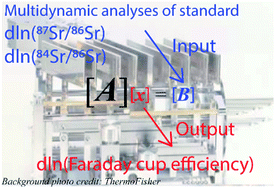Monitoring and quantitative evaluation of Faraday cup deterioration in a thermal ionization mass spectrometer using multidynamic analyses of laboratory standards†
Abstract
Accurate and precise isotopic ratio determinations using multi-collector (MC) mass spectrometers rely on accurate cross-calibration and long-term stability of the efficiencies of the multiple detectors. Isotopic analyses at the part per million (ppm) level of precision, which are commonly carried out with a thermal ionization mass spectrometer (TIMS) equipped with arrays of several Faraday cups, are the most sensitive to detector efficiency variations. Quantitative characterization of the Faraday cup efficiency change (also known as Faraday cup deterioration) during instrument usage can assist the analyst in making decisions about the replacement or cleaning of Faraday cups and in making corrections to the measured isotopic ratios, which are both essential to sustain the high measurement accuracy and long-term reproducibility of MC-TIMS. In this study, we present a method to quantitatively and continuously track the deterioration degrees of individual Faraday cups on MC-TIMS. The advantage of this method, compared to the previous ones, is that it uses only the results of regular repetitive analyses of laboratory standards, and no additional, specially designed experiments are required. Using this method, we monitored the performance of Triton Plus MC-TIMS at the Research School of Earth Sciences, the Australian National University, during a 6 month Sr isotope analytical session, and observed significant Faraday cup deterioration up to 150 ppm. The cups that have received the most abundant Sr atom deposition during the analytical session deteriorated the most, confirming that the accumulation of measured elements is the likely cause of changing Faraday cup efficiencies. The response of the cup efficiency to the accumulation of Sr atoms in the cup is complex and non-linear, and differs between cups in magnitude and direction, suggesting that Faraday cup deterioration is not a simple univariate function of the accumulation of measured elements.



 Please wait while we load your content...
Please wait while we load your content...